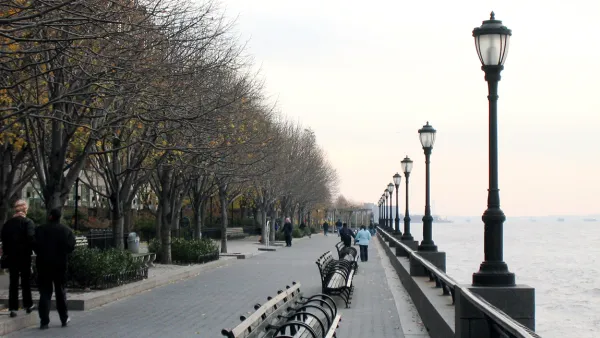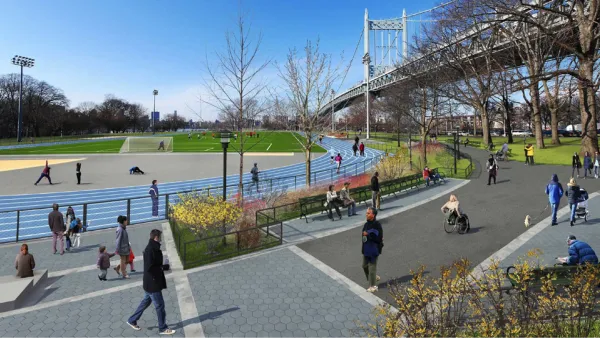The Parks Without Borders program in New York City is intended to open parks to the rest of the public realm, but some local activists like their parks just how they are.

Design changes proposed for Fort Greene Park in Brooklyn are creating controversy for the New York City Parks Department's "Parks Without Borders" program, according to an article by Kendra Hurley.
Parks Commissioner Mitchell Silver told Planetizen in an interview published earlier this year that the Parks Without Borders program is "removing fences, opening up sight-lines, breaking down walls, and converting sidewalks and streets next to parks into plazas."
The changes proposed for Fort Greene Park under the auspices of the program are too radical for a local organization called Friends of Fort Greene Park. Their complaint: that "the bulk of the redesign dishonors the historic vision of the park’s creators, Frederick Law Olmstead and Calvert Vaux, as well as the wishes of those who use this part of the park most, and especially the residents living in the housing developments across the street."
Rachel Sugar reported similar controversy with the same park and the same program in 2017, but Hurley suggests that the controversy with the Parks Without Borders program is not isolated to Fort Greene Park. "In a handful of other neighborhoods slated to receive the Parks Without Borders treatment, the program has been rife with controversy, inspiring some community members to rally in protest of proposed plans, but sometimes finding they have little recourse to stop them," according to Hurley.
The article includes a lot more context, in the form of anecdotes from activists in neighborhoods where the Parks Without Borders program has attempted parks redesigns.
FULL STORY: NYC ‘Parks Without Borders’ program draws controversy

National Parks Layoffs Will Cause Communities to Lose Billions
Thousands of essential park workers were laid off this week, just before the busy spring break season.

Retro-silient?: America’s First “Eco-burb,” The Woodlands Turns 50
A master-planned community north of Houston offers lessons on green infrastructure and resilient design, but falls short of its founder’s lofty affordability and walkability goals.

Delivering for America Plan Will Downgrade Mail Service in at Least 49.5 Percent of Zip Codes
Republican and Democrat lawmakers criticize the plan for its disproportionate negative impact on rural communities.

Test News Post 1
This is a summary

Test News Headline 46
Test for the image on the front page.

Balancing Bombs and Butterflies: How the National Guard Protects a Rare Species
The National Guard at Fort Indiantown Gap uses GIS technology and land management strategies to balance military training with conservation efforts, ensuring the survival of the rare eastern regal fritillary butterfly.
Urban Design for Planners 1: Software Tools
This six-course series explores essential urban design concepts using open source software and equips planners with the tools they need to participate fully in the urban design process.
Planning for Universal Design
Learn the tools for implementing Universal Design in planning regulations.
EMC Planning Group, Inc.
Planetizen
Planetizen
Mpact (formerly Rail~Volution)
Great Falls Development Authority, Inc.
HUDs Office of Policy Development and Research
NYU Wagner Graduate School of Public Service




























